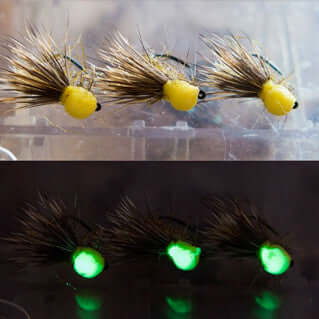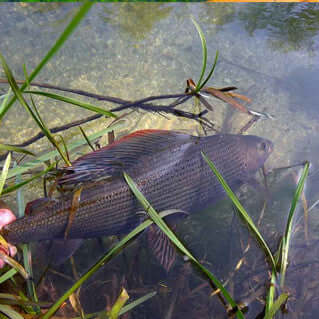A fly line is a wired projectile.
It’s thrown by a rod but it remains tethered to the reel or rod in the case of Tenkara. It’s similar to a harpoon in this respect, or even a taser. In fact, remind me to call a line that, Taser!
There are 2 types of energy involved in throwing a fly line. Stored / Lever energy in the rod and kinetic energy that travels through the line as it flies. I’m less interested in the debate about the exact type of energy a rod uses to propel a line, and more interested in what happens when it’s cast.
Loop
What is a loop? It’s a confusing term because it conjures images of all sorts of shapes and knots or circles or nooses or whatever the hell it is. But in the case of fly lines, we generally know it means that aeroplane nose shape the line makes when it flies. Some loops remind me of WW1 tank tracks, the shape they make.

The fly line loop
There are 2 elements to the loop. The top and bottom leg. The bottom leg remains tethered to the caster somehow, this is the wired bit. That doesn't move, unless we shoot line. Even then it should move slower than the top leg which is pulled around the nose end of the loop as it travels, thus creating ‘turnover.’ Sounds complicated but you all know what I mean, you see it. It ‘aint rocket science.
The bit that is complex, when we come to design a fly line though is how fast we make that top leg come round. Or, how fast both legs travel through the air. Or, how much friction we apply to the running line. All these factors affect what I call, the speed of the line. When I design a line I choose a core and a coating, then taper. The choices I make determine the speed those materials travel. The speed kinetic energy is allowed to travel through and around the shapes they make.
Core and coating speed
As I say, it’s not rocket science, the thinner and more dense the core the faster it transmits energy. Hi fi speakers are measured by their impedance. Low impedance speakers require very little energy to create the desired level of sound, and the desired level of quality of that sound. Cores and coatings are exactly the same. The lines I make are like digital signals. Fast, efficient and clean. Some lines remind me of analogue signals, old MW signals. Crackly and full of noise, in our case manifesting themselves as slack in the cast and a general lack of presence / speed as they fly. As a general rule any high viz fly line will be slower and less ‘clean’ because the pigments used to get the colour are usually less dense. They have a lower specific gravity. Great for super floaty. Poor for super casty.
So, with current materials available, in my opinion the fastest, cleanest signal you can get is a solid monofilament core. The most direct, dense route for energy to travel. No braids, no hollow cores, just a dense solid cable through which to travel.
That doesn’t mean you should always use monofilament cores. They present multiple issues. They sink, attract water and are very hard to bond to. In thicker diameters they exhibit memory too. It’s always a trade off between what you are trying to achieve / application and your market to be honest. Certain countries prefer more floaty and more visible. In the States, go ahead, use a braided core and break out the high viz orange. It ‘aint gonna fly in New Zealand or on the Test though, at least not usually, and that is changing. The market is gravitating back to stealth.
Heat, durability, specific gravity, colour and tensile strength all have to be considered when choosing core.
Coating
People attribute memory issues to the core. They attribute sensitivity to the core. They attribute strength to the core. Core affects all these parameters, but not exclusively and in some cases, very little compared to coating.
You have to trust me when I say i can make thin, fast coatings that float and I can make slow, thick coatings that float. I can make either sink.
So let’s take some mono off the top shelf (all mono is top shelf tackle) and pull out the ‘fast and thin floaty coating’ bucket, ready for production. This is shaping up to be a micro thin fly line, 20-30% thinner than regular PVC lines. It’s going to fly fast, very very straight, very true and very far. It’s the Ferrari of wired projectiles. If it’s 25% thinner then we have far less of it to move. So, that requires much less effort for me to cast it and for a fish to move it. Enter stage left, super sensitive fly lines. No one has even discussed core stretch, the figure that everyone seems to hang all sensitive arguments on. Diameter, now there’s a subject worth discussing when it comes to sensitivity.

Staring at the Mac!
We’ve made the line sensitive. What about making it cast further for less effort? Enter stage right friction, or the lack of it due to reduced diameter, and improved aerodynamics. So the line has less air resistance and it’s not held back by the rod rings. Do we still need the stored / lever energy in the rod? Nope. We don’t need as much. We have 2 choices here, either go out and buy non carbon gear and maintain our casting effort or reduce our casting effort using our super duper carbon laser wands. Simply put, thinner lines don't need stiff rods and strong arms, or at least they don't need the weight to bend the rods as deeply. So, we can make the lines truer to AFTM ratings for an equivalent effect, right?
We’ve reduced the drag through air, water and the rod rings. We’ve maintained the buoyancy and casting weight required. Now we can get to the bit that everyone focuses on first! The taper.
Taper
Isn’t it ironic (as Alanis said) that now we’ve addressed the actual physics and chemistry of the wired projectile we look at the shape of it last? I mean, isn’t taper the thing that we all used to look at first? 99.9% of casting instructors on the planet will discuss fly lines in terms of one concept, taper. For me, it’s a tiny detail that affects the practical nature of how far it flies, what it casts, what it’s cast on and where in the world it’s cast. Believe it or not, that’s the easy bit. We’ve gone to lengths of polymer chemistry and pigment selection, core and primer science, we’ve made the proverbial ball of play dough. All we have to do is roll it out into the shape we want. It’s the ball of play dough that’s the hard bit, not the shape. There are computers and testing for that. Easy Peasy.

Actual factory taper specs of a micro thin fly line
What’s the best bit about double taper lines? They are more delicate because they have better front tapers? Nope. They can be turned around? Sure, but your rod cost £650 so what’s the issue? They are better for roll casting? Gibberish.
THEY ARE THINNER!
Generally, the reason why DT lines are considered better is that they are rolled out sausages. Thinner. They have no concentrated weight at 30’ to load the rod. Therefore, they have less diameter and land a little more delicately. That’s counteracted though because they are constantly one diameter. So, hauling them is harder. The running line is the same diameter as the head. Re introduce ladies and gentlemen, friction. The thing we worked so hard to eliminate.
The loops when you haul are less stable and contain more ‘noise.’ They are generally only better with pick up and lay down casts. Simple. That is unless you make a micro thin shooting head which is thinner than a double taper anyway, shoots like a Rio Outbound and lands like a line 3 times lighter than it’s AFTM. Now that’s a line I’d buy. In fact that’s a line I’d make. In fact, they are the lines I make….
So taper is relevant to core and coating also. The thinner the line the more you have to adapt the taper. The Jeremy Lucas Dry Fly has a 14-18’ front taper. You couldn't make a front taper that long, tapering to 0.55mm and still get it to cast up to 4 weight flies, if you used regular ‘MW’ cores and coatings. The energy wouldn’t get to the end of the leader. it would fail. Too slow, Too much slack.
Speed of coatings affects speed of tapers. It’s a complex relationship between air resistance and mass. That’s what testing is for. You don't have to be an aerospace engineer to calculate it right first time. You try, you test, you tweak. Done.
There’s a lot I haven't been able to talk about in this article but there’s more than you’ll read elsewhere for sure. I’ll end on this, whatever lines you buy, look at colour first, shape and diameter second and slickness third. Lubricity is worthy of a 10,000 word dissertation on it’s own and has a profound effect on loop stability and shape. My honest thoughts, only 10% of anglers would benefit from 60% improvements in lubricity, long term.
A good fly line is a work of art. It’s a fine instrument. I see a lot of people wanting to play like Eric Clapton, buying Fenders, but they’ve never had a lesson. Same gig. Fly Casting is very hard actually, requiring lots of good tuition and practise to do really well. I make fly lines for all abilities but all my lines can perform to a very high level in the right hands. I call it the 'ceiling.' They have very high ceilings and you'll never really out perform them.
































